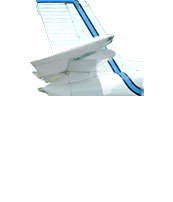Mechanical Systems Overview Conce........rns...................... pages: 1 | 2 | 3
With the exception of ground operations, the two major sources of supply air to the cabin are the aircraft engine compressors and the APU. The selection of the source (aircraft engines, APU, or some ground source) will largely depend on the phase of flight, the aircraft type, and the airport facilities. The supply air, whether from the aircraft engines or the APU, is then cooled, conditioned, mixed with about 50% recirculated air, and supplied to the cabin.
The aircraft engine compressors are the primary source of air to the cabin. Most of the air compressed in the aircraft engines is used for engine thrust, but a portion of that compressed air is "bled off" and routed to the air conditioning system, hence the term “bleed air.” The APU is the auxiliary source of power and air. It too is essentially an engine, but it is independent of the aircraft engines, and it sits, in most cases, in the tail of the aircraft. The APU is often used for air supply on the ground, and on many aircraft types, it supplies the cabin with air during takeoff and ascent when the aircraft engines need all of their compressed air for engine thrust.
In the APU, the moving parts are lubricated with oils that can be heated to high temperatures during operation. Usually these hot oils are kept separate from the compressor, but sometimes (whether it is because of a leaky seal, a cracked joint, or overfilling by maintenance workers), the heated oils (or the gases that are generated) can leak into the air supply. The APU can also ingest any fluids that leak or spill into the belly of the aircraft and make their way to the aircraft tail (where the APU is typically located) according to the line of flight. This includes hydraulic fluids, deicing fluid, and fuel.
Like the APU, the engines – whether mounted on the wing or the tail – are full of moving parts that are lubricated with oils, and those hot oils can leak into the compressors and enter the air supply. In addition, wing-mounted engines can ingest deicing fluids and hydraulic fluids that leaked from local hydraulic systems in the event of a line break, for example. Tail-mounted engines may ingest hydraulic fluids that leaked from hydraulic systems throughout the aircraft, such as those used to control the wing flaps, the landing gear, and the flight controls. Like the rear-mounted APUs, tail-mounted engines may also ingest any other fluids that accumulate in the belly of the aircraft.
